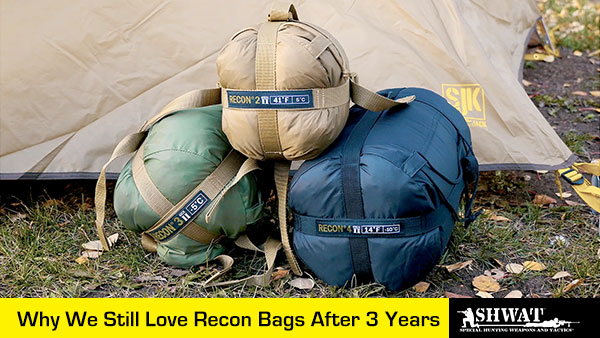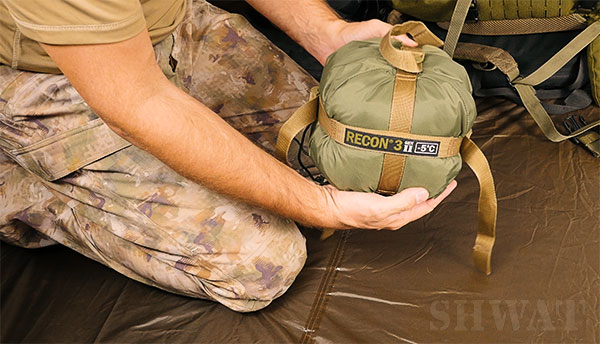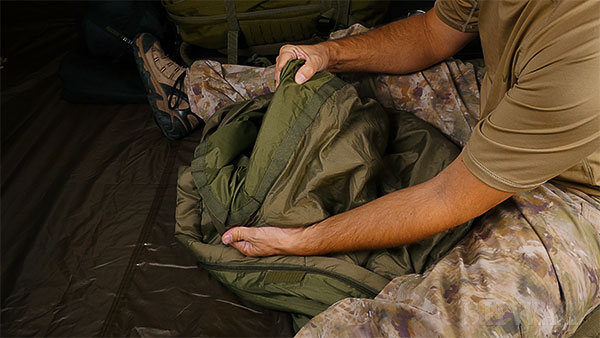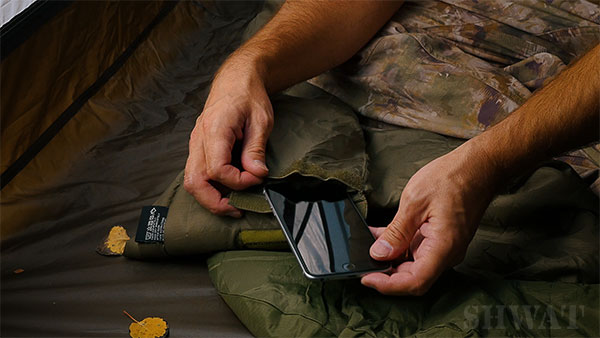 If you’re the kind of adventurer who’s HQ is a tent whether hunting, scouting, or just having fun discovering what you can find over the next ridge, you need a sleeping bag. For about three years of adventures now, I’ve been waking up inside a Recon sleeping bag. I’ll share some info here in text and other in the video at the bottom of this story.
If you’re the kind of adventurer who’s HQ is a tent whether hunting, scouting, or just having fun discovering what you can find over the next ridge, you need a sleeping bag. For about three years of adventures now, I’ve been waking up inside a Recon sleeping bag. I’ll share some info here in text and other in the video at the bottom of this story.
Sleeping bag ratings are a joke, unless you understand them. I’ve seen reviews online slamming one brand or another because the bag was cold at the rated temperature. Let’s be real here – can we agree that comfort is subjective? I might be perfectly happy in a cool environment while my wife feels the need to bundle up. So any reasonable sleeping bag rating system must be based on something besides the subjective feelings. Essentially, bags are often rated for some temperature at which you won’t die from cold while inside the bag. That’s hardly a projection of comfort, and a bit of an over simplification.
In my experience, a base layer is a big deal. How heavy a layer? Well now we’re back to the subjective part. So I’m not going to list a bunch of stats like, “In the Recon 3 I was perfectly comfortable at this temperature, with that humidity level, and a particular level of base layer.” Keeping it real again, I’ve awakened cold in the middle of the night in a Recon bag. Why? I didn’t get the base layer right. Big deal, I’ve always had what I needed and added it. And then I became comfortable again. But that’s just me. You might not have needed as much base as I did on that particular night at the other specific humidity…
With that out of the way, let me share what I’ve really come to appreciate about these bags.
Probably the biggest thing I noticed was how small these bags are when compacted in their compression bags. I’ve personally been using a 2.98 pound 23°F rated Gen II Recon 3 bag for about three years. Recently I added a Recon 2 (2.5 pounds and rated to 41°F) and Recon 4 (3.5 pounds and rated to 14°F) to the collection. I may compress mine a bit more than the official stats. My unscientific take is that the Recon 2 takes up about the same space as a volley ball, the Recon 3 a basket ball, and the Recon 4 is just a little bigger. Granted, the shape is different, but you get the idea.
 The insulation used in Recon bags also allows them to stay compact. DuPont® Thermolite™ Micro insulation is flat filled so you have even warmth all around. There won’t be cold spots due to uneven spots of insulation or quilting lines. The insulation won’t compress and squeeze warm air out. It’s high tech stuff that has even been used in high altitude sky diving suits.
The insulation used in Recon bags also allows them to stay compact. DuPont® Thermolite™ Micro insulation is flat filled so you have even warmth all around. There won’t be cold spots due to uneven spots of insulation or quilting lines. The insulation won’t compress and squeeze warm air out. It’s high tech stuff that has even been used in high altitude sky diving suits.
Unpacked, the bags in the Recon line are all sized the same 86.5” long, 33.5” wide at the shoulders and 21.5” at the feet. The amount of insulation, however, is what makes the warmer bags bigger and heavier. To give you an idea, the Recon 4, rated for 14°F has double the insulation of the 23°F rated Recon 3. The insulation is made a little more effective by an ultra-thin barrier of pure silver anti-bacterial micro fiber.
The construction of the bags is pretty cool, too. The bottom layer fabric (the long piece that goes on the ground or your sleeping pad) is 210D Nylon and puts a waterproof barrier between you and the ground. The topside outer shell is lighter and Teflon coated to help repel dirt. This keeps the top outer shell cleaner, which means you stay cleaner when you unzip the center line zipper. I guess that’s less of an issue for a side zip bag, but as you’ll see in the video, center zips have some real advantages. And the zipper is super smooth, easy to close and even easier to open. The softer inner shell is made of 210T Ripstop Nylon.
Recon bags were originally designed for military use and remain in service around the world today. As such, they are slightly oversized and benefit from an internal foot baffle. Reinforced with 210D Nylon Oxford with PU2000mm waterproof finish to limit damage from boots, the baffle allows you sleep ready to go. Does that matter? I guess it depends on your 2:00 a.m. habits, not to mention the added warmth your feet can benefit from while still in your boots.

The bright green is the heavier fabric that allow you to wear your boots to bed and not worry about tearing up your bag.
But what if you’re boots are dirty? Just wash your back and hang it to dry. Easy.
Ever notice how your cell phone, flashlight or GPS battery can run out of power a whole lot faster when it’s cold? Recon bags feature an internal pocket so you can keep those things inside, warmed by you, slowing the rate at which your battery dies. Great idea, and I use it. The only downside here is that with the growth of cell phone size the pocket requires me to remove the case from my plus sized iPhone for it to fit. I asked the now USA based maker about it and understand that the pocket should grow soon. Hopefully our phones don’t get much bigger or we’re all permanently in cargo pants.
 Currently, the available colors include Olive Drab, Black and Coyote Tan. From lightest to heaviest, here’s retail pricing (though shopping around can save you some money): Recon 2, $149.95; Recon 3, $189.95; Recon 4, $209.95; and the Recon 5 that I’ve not tried, $239.95. It’s rated to -4°F. That’s chilly.
Currently, the available colors include Olive Drab, Black and Coyote Tan. From lightest to heaviest, here’s retail pricing (though shopping around can save you some money): Recon 2, $149.95; Recon 3, $189.95; Recon 4, $209.95; and the Recon 5 that I’ve not tried, $239.95. It’s rated to -4°F. That’s chilly.
Want to know more? Watch the video and then head over to the Recon website: ReconBags.com. As you already know, I’m quite happy with these. Now I just need to find more time to use them over the coming three years!


Just take my money! I’m still using the same sleeping bag I used in the Boy Scouts and it looks like it too. LOL! The Recon’s compact size is a really attractive feature as mine is a more traditional size. Something to consider…